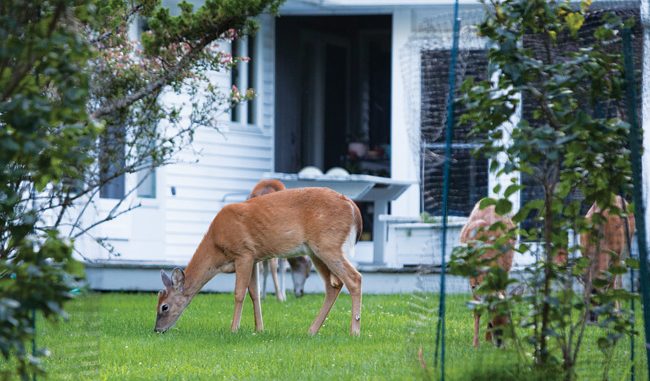
It’s that time of year again — high season for deer-car collisions.
This fall, Southold Highway Dept. workers are picking up an average of one dead deer a day, “and some days we’ll do pickups throughout the day,” said highway superintendent Dan Goodwin, describing that pace as consistent with previous autumns. Mr. Goodwin said that through the beginning of November, 523 deer carcasses had been brought to the town landfill, either by highway dept. staffers or residents.
On Shelter Island at this time of year, “we’re good for three to four a week, at least,” said Ken Lewis Jr., the island’s superintendent of highways and commissioner of public works.
In Riverhead, Mike Zaleski’s highway department staff averages between five and 15 — and sometimes as many as 20 — dead deer a week.
“During hunting season, they get flushed out more, so we definitely pick up more dead deer,” said Mr. Zaleski, a 30-year veteran of the Riverhead Highway Dept.
October through December is the most dangerous season for deer strikes on the North Fork, and across Suffolk County — which last year ranked third out of 62 New York counties for the most annual animal-involved collisions, according to AAA, up from sixth place in 2022. In 2021, Suffolk county had the second most animal collisions statewide.
It’s a perfect storm combo each fall when deer mating season and hunting season coincide with diminished food sources and days where dusk falls around 5 p.m. — when many drivers are commuting home from work.
During mating season, hormone-packed bucks are racing around chasing does.
In their mating season, “they’re more active, they’re up on their feet more often,” said Mr. Goodwin. “There’s less sources of food out there. What’s left of our farms have got cover crop in the fields, so they’re out searching for food and moving around. There’s also not as much camouflage because the trees have dropped their leaves.”

The Riverhead and Southold figures don’t include state and county roads, officials said.
“We don’t do anything on [Route] 25 and we don’t do anything on Route 48,” Mr. Goodwin said. “Those are all picked up by the state or the county.”
In Riverhead, Mr. Zaleski said that deer pickups don’t include the Long Island Expressway or county roads like Route 58.
On Shelter Island, Mr. Lewis’ highway department handles everything, including Route 114.
“The majority take place on the state road [Route 114], which is probably the busiest thoroughfare for us, because it connects the two ferries,” he said. “And we’ve become a busier place for trade traffic that crosses over from the North Fork to the South Fork, using us as a sort of bridge. So that state road deals with quite a bit.”
If a deer does run out in front of a car, the best thing for a driver to do is not to swerve, experts said. Instead, hit the brakes and honk the horn, which may be enough to startle the animal out of the way. If a crash is inevitable, the best course is to steer into the deer.
“Drivers should never swerve to avoid any animal, especially on country roads,” AAA Northeast spokesman Robert Sinclair Jr. said in a statement last fall.
The reason is simple: Swerving to the right could send the car into a ditch, tree or telephone pole, while swerving left could result in a deadly head-on crash with an oncoming vehicle.
“While it’s not desirable, hitting a deer is better than hitting a tree,” Mr. Sinclair said.
In Southold and Shelter Island, the carcasses are compacted and trucked away by waste management services, while Riverhead buries its own.
“We have a deer pit on town property, in a brush yard of ours,” Mr. Zaleski said. “It’s a hole in the ground, and we fill that up. As they decompose, we put a layer of mulch over them, to keep the smell down and help with quicker decomposition. When the pit fills up, we simply dig another hole.”
Town highway workers also pick up and discard of other animal roadkill, from squirrels and turtles to possums and raccoons.
“It’s not one of the more glamorous parts of the job, that’s for sure,” Mr. Goodwin said.

